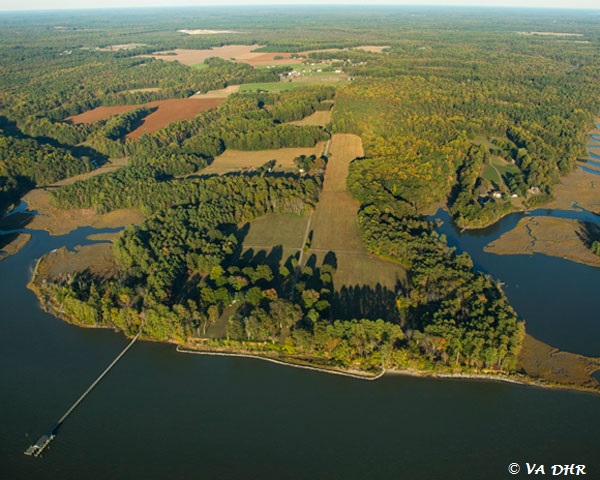Werowocomoco conserved, key site along Capt. John Smith Trail
The Chesapeake Conservancy commended the Virginia Department of Historic Resources for their work to conserve Werowocomoco, the principal residence and headquarters of Powhatan, the Paramount Chief who united many of the Chesapeake’s tribes in a confederacy that controlled much of the region and was the dominant political force when English settlers arrived at Jamestown in 1607.
 The Department of Historic Resources put an easement on 58 acres of a property owned by Lynn and Bob Ripley to protect the core archeological area located on the north bank of the York River. Archeological investigations conducted through a partnership between the Department and the College of William and Mary and in cooperation with Virginia Indians identified the site. Excavations and study at the site has been going on for a decade.
The Department of Historic Resources put an easement on 58 acres of a property owned by Lynn and Bob Ripley to protect the core archeological area located on the north bank of the York River. Archeological investigations conducted through a partnership between the Department and the College of William and Mary and in cooperation with Virginia Indians identified the site. Excavations and study at the site has been going on for a decade.
Archeologists have identified unique features at the site including the footprint of a 72-foot longhouse, and have found that the town was settled at least as early as 1200 A.D. They have also found features that suggest the town had longstanding religious significance, in addition to its function as the seat of government for the Powhatan Confederacy.
The site is along the Captain John Smith Chesapeake National Historic Trail, and the Chesapeake Conservancy, which is the principal nonprofit partner to the National Park Service to develop the trail, has been strong advocate for the protection of Werowocomoco.
Stephen R. Adkins, Chief of the Chickahominy Indian Tribe and a founding board member of the Chesapeake Conservancy, led the Conservancy support for conservation of the property.
“As a member of the Chesapeake Conservancy and as Chief of the Chickahominy Indian Tribe, I am very pleased to see 58 acres of Werowocomoco placed into conservation,” Adkins said. “The preservation and conservation of this historic land for generations to come is perfectly aligned with my values and the values of the Chesapeake Conservancy. Hopefully, I will live long enough to see the entire site of Werowocomoco placed into conservation.”
Chief Adkins spoke at the dedication of the conserved site on June 21. He said that the excavations and study of the site “rip to shreds the offensive Anglo Centric term pre-history as it relates to the history of this land and its indigenous people prior to the arrival of the invaders in 1607. Today we honor the polity, social order, economic enterprise, religious customs, agricultural prowess, engineering feats and craftsmanship of our ancestors who thrived in this area thousands of years before the settlers landed in 1607. Today my hope is that all of academia will look at the terms pre-contact and pre-history and conclude that a thriving society was here well before 1607. And finally lets embrace the fact that the history of this land Tsena Comoco and its people did not end nor did a new history begin in 1607.”
Joel Dunn, Executive Director of the Chesapeake Conservancy, said the Conservancy had supported the conservation of the property because “protecting Werowocomoco protects the history of all Virginia Indians and will help us better understand the history of the Chesapeake from long before the English settled Jamestown as well as what happened during those years when Capt. John Smith met Powhatan.”
Captain John Smith visited Werowocomoco twice. The first time was as a captive, having been taken prisoner while exploring the Chickahominy River. During that visit he befriended Pocahontas, Powhatan’s young daughter. From that meeting, the tale of John Smith and Pocahontas evolved. He returned later to trade. The site is identified on Smith’s maps of 1608 and 1612, and is about 15 miles from Jamestown.
The National Park Service is collaborating with the Department of Historic Resources to produce an illustrated book designed for visitors and the general public on the story of Werowocomoco.